-
Guide to Tire Pressure Monitoring Systems

Notice to our customers: Important changes affecting vehicles equipped with Tire Pressure Monitoring Systems have been put into place.
Learn More
What Is a Tire Pressure Monitoring System?
TPMS stands for Tire Pressure Monitoring System. It is a feature on many late model vehicles that monitors tire pressure and warns the driver, with a light on the dash, if one or more of the tires’ pressure falls 25% below the original equipment manufacturer’s recommended tire pressure.
See the questions below to learn more about TPMS, and how to check if your vehicle is equipped with TPMS.
Why does TPMS exist?
As a result of tire-related safety concerns, Congress passed the TREAD Act in 2000. The TREAD Act requires vehicle manufacturers to install TPMS in new vehicles with a gross vehicle weight of 10,000 pounds or less.
What vehicles have it?
Passenger cars, SUVs, and light trucks. TPMS has been progressively introduced in new vehicles since 2005. Refer to your owner’s manual for more information.
How do I check to see if my vehicle has it?
When you start your vehicle, look at the dash for the TPMS warning lamp. If you see the warning lamp light up momentarily, your vehicle is equipped with TPMS.
What does it mean when the warning lamp is on?
The warning lamp should light up briefly when the vehicle is started. But if the light stays on, that means tire pressure is low in one or more of the tires, or the system is not able to read the sensors. In this case, you should have your tire air pressure checked. We provide this service for free at all of our Les Schwab locations.
What kind of maintenance is required on my TPMS?
Replacement or relocation of a TPMS sensor, or sometimes even just inflating a tire may cause the TPMS to get out of whack. Generally, recalibration is easy to perform: we provide this service to customers free at all Les Schwab Tire Centers.
Does this mean I don’t need to check my tire pressure?
Regardless of TPMS, we recommend tire pressure checks every 30 days. Properly maintained tire pressure decreases tire wear and improves vehicle safety, handling, braking and fuel mileage. Come in anytime for a free air check.
Find Your Store -
Run-Flat Tires: How They Work & When Should You Use Them
No matter where you drive, one stray nail or screw can cause a flat tire and send you to the side of the road. Run-flat tires change all that. However, there are trade-offs. Here’s what you need to know about run-flat tires, why some manufacturers are using them instead of spare tires, and why you might or might not want them for your vehicle.
What Are Run-Flat Tires?
Also called zero-pressure tires, run-flat tires are designed with reinforced, thicker sidewalls. They’re about ¾" thick as compared to ⅛" thick on standard tires. This means the sidewalls of the tire should be able to support the weight of your vehicle even if you experience a sudden and complete loss of air pressure due to a puncture or tire failure.
Additionally, some run-flat tires allow you to travel for a short distance at speeds of up to 50 miles per hour. In other words, they live up to their name and are built so you can skip the spare and drive on them even when they are technically flat.
How Long Can You Drive on a Run-Flat Tire
Run-flat technology is designed to help you remain in control even after losing all or most of the air pressure in your tires. If you get a flat, some run-flat tires allow you to drive for up to 50 miles at up to 50 miles per hour. That should be enough to get to your local Les Schwab for a repair or replacement.
How Do Run-Flat Tires Work?
Standard tires do not support the weight of your vehicle. The air pressure does that job. When a standard tire loses air pressure, the sidewalls on those tires fold and the tire becomes unsafe for driving. If you go too far, you can ruin the tire and maybe even the wheel.
Run-flat technology also uses air pressure to support the weight of your vehicle, but the sidewalls on run-flats are reinforced so that even if you experience a sudden and complete loss of air pressure, you can stay in control and drive for upwards of 50 miles to a nearby Les Schwab. As long as there is no damage to the sidewall or other parts of the tire, we may be able to repair your run-flat tire. However, the damage warranty, if there is one, might not cover the damage.

How Run-Flats Compare to Standard Tires?
When purchased from us, both come with the Les Schwab Tire Warranty for the life of the tire. Additionally, both technologies fit onto standard wheels or rims. See our article Can I Mix Run-Flat Tires with Standard Ones for some added insight.
The Benefits of Run-Flat Tires
- Safety: More control in the event of a sudden loss of tire pressure.
- Options: The ability to drive to your local repair shop after a flat.
- Convenience: No need to carry a spare or change a tire on the side of the road.
The Disadvantages of Run-Flat Tire Technology
- Comfort: There can be diminished ride quality with the stiffer sidewall.
- Noise: Some run-flat tires create more road noise inside the vehicle.
- Repairs: While run-flat tires might get you to a repair facility, the tire might not be repairable in most situations.
- Cost: Most run-flat tires come at a premium price.
- Availability: Some specific sizes and tread options may not be readily available.
When Should You Use Run-Flat Tires?
Roughly 15% of all new vehicles sold in the U.S. come with run-flat tires, according to the National Highway Traffic Safety Administration (NHTSA). In most cases, this means the vehicle does not have or was not equipped with a spare tire, reducing the weight of the vehicle and increasing cargo space. If you want to free up space in your trunk or under the vehicle, and want the added freedom of driving on a “flat” tire for up to 50 miles instead of stopping to change to a spare, you might consider choosing run-flat tires.
Why Were Run-Flat Tires Created?
If you’ve purchased a new car, you may have noticed that many manufacturers have removed the spare tire. This is done to reduce weight, improve fuel efficiency, and provide more cargo space. But what happens if you get a flat? You’ll find that those carmakers may have given you an emergency tire repair kit or equipped the vehicle with run-flat tires.
When it comes to convenience, run-flat tires are great. But the real reason they were invented was to improve the safety and steering response of high-end sports cars in case of tire failure. Over the decades since this technology was first introduced, run-flat tires have become more common on some high-end vehicles.
Ask Les Schwab About Run-Flat Tires for Your Vehicle
If your vehicle came standard with run-flat tires, you might consider it as a viable option — especially when your vehicle does not have a spare. If your vehicle did not come standard with run-flat tires, or if you’re unsure if you already have run-flat tires, stop by your local Les Schwab for advice. Depending on your vehicle and driving needs, our team can help you decide if run-flat technology is right for you.
-
Tire Siping
What Is Siping and How Is It Done?
Siping is a process that involves adding thin slits to the surface of the tire. These thin slits increase the number of biting edges in the tread. Siping is done by placing your tires on a specially designed machine that rotates your tires while making small 90-degree cuts in your tread. Les Schwab Tire Centers offer this service at all our locations. Stop by your local Les Schwab, and we will be happy to discuss whether siping is a good option for your tires and driving experience.
-
How to Choose the Right Truck Tire
Choosing the right tires for your vehicle is an important decision. When you drive a light truck, SUV, or crossover, the tires you choose can have a direct impact on traction, comfort, road noise, tread life, and durability. Here’s a quick guide to help you decide what truck tires are the right fit for your on- and off-road needs.
H/T (Highway Terrain) Tires for Daily Commute and Highway Driving
Chances are your SUV, crossover, or light truck came standard with a set of H/T tires built for highway driving. If you don’t plan on going off-road, and want a tire that’s great for dry and wet road conditions, then an H/T tire is probably a good option.
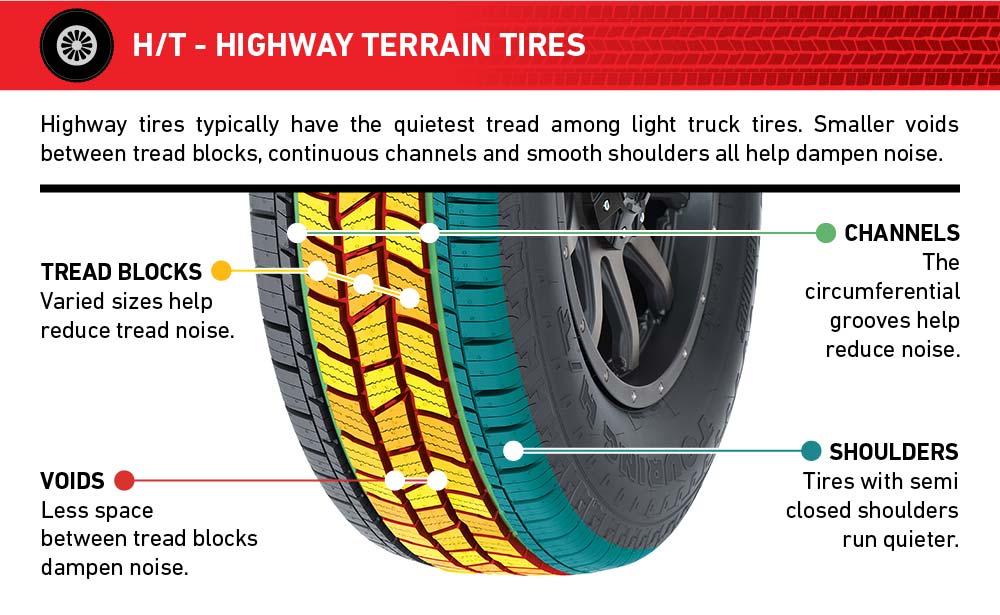
Benefits:
- Smooth and quiet ride
- Wet weather performance
- Long tread life
Les Schwab Tip: H/T tires aren’t designed for prolonged use on gravel roads or in off-road conditions. If you plan to take your vehicle off the highway, it may be best to upgrade to an A/T tire for better traction and performance.
A/T (All-Terrain) Tires for On- and Off-Road Performance
Drivers who regularly find themselves taking dirt and gravel roads in between long stretches of highway driving, should look at A/T tires. This includes folks who like to take the road less traveled on their way to a great camping spot or other outdoor activity.
The deeper tread design is optimized for a comfortable ride on pavement, but built to grip in other conditions. Additionally, some A/T tires are built for all-weather, year-round driving including snow and rain.
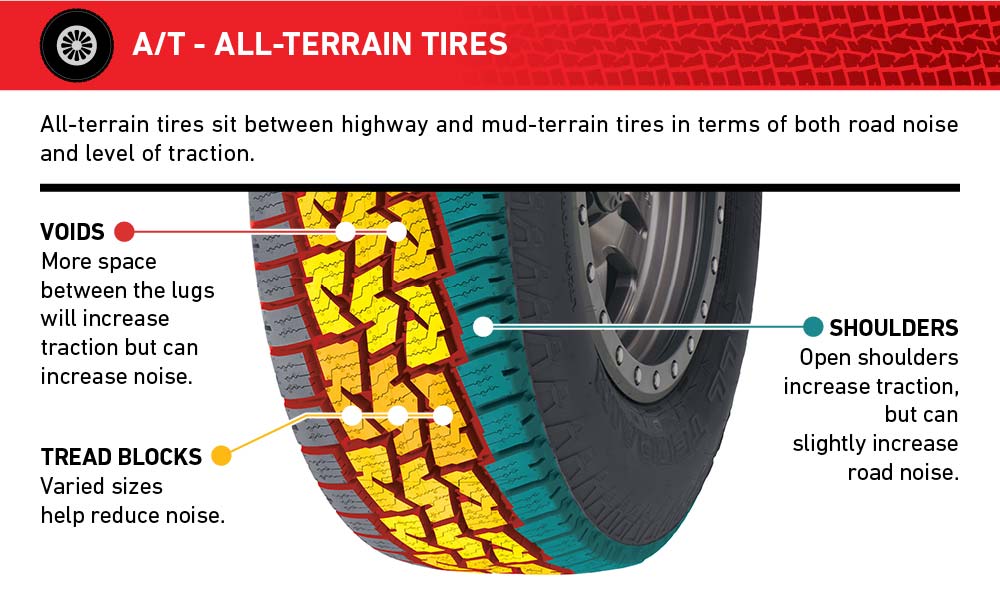
Benefits:
- More aggressive looks (gives your vehicle a great appearance)
- All-weather traction (including wet and winter conditions)
- Long tread life
- Durability
Les Schwab Tip: Because A/T tires are more rugged than H/T, there can be a slight increase in road noise. However, A/T tires offer the best of both worlds with comfortable daily driving, off-road performance, and visual appeal.
M/T (Mud Terrain) Tires for Off-road Enthusiasts
You know who you are. You drive a rig that is either lifted or already offers plenty of clearance for your favorite pastime: driving in extreme off-road conditions, including mud, dirt, gravel, and rock. Or maybe you just like the way a set of rugged, aggressive tires looks on your vehicle, even if they never leave the blacktop. Either way, M/T tires are for you.
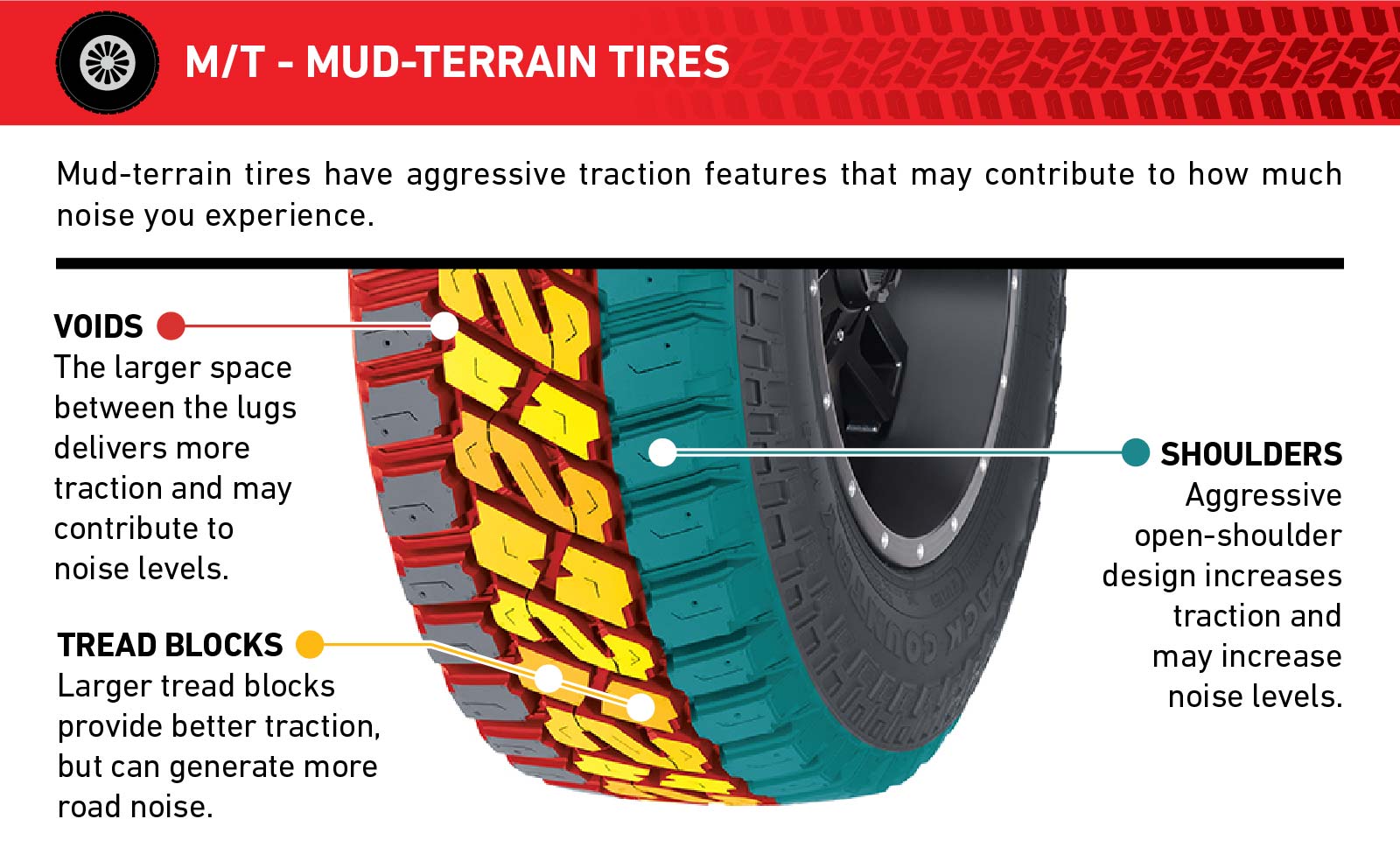
Benefits:
- Aggressive looks
- Maximum durability
- Ultimate traction in mud, dirt, rocks, and gravel
Les Schwab Tip: M/T tires were first created for military and forestry applications, which means they’re designed for extremely rugged conditions. Because of the special tread design, they can be noisier than A/T and H/T options.
Get the Right Tires for your Truck at Les Schwab
Our professionals can give you advice based on your driving needs. Stop by today and we'll show you all of your options and how the Les Schwab Tire Warranty works for you. That includes our no-hassle road hazard protection, a 60-day satisfaction guarantee, and free tire maintenance at any Les Schwab location.
-
Tire Size Explained: What Do The Numbers On The Side Of A Tire Mean?
Whether you’re switching out your tires for a different look or added performance, a good place to start your search for that new tread is the sidewall on one of your existing tires. The numbers and letters on that sidewall represent everything from the tire type and width to the aspect ratio, construction type, diameter, load index, and speed rating. Here’s how to read the sidewall on your tires.
Tire Size Meanings
The numbers and letters on the sidewall can be confusing. Here’s what each one means.
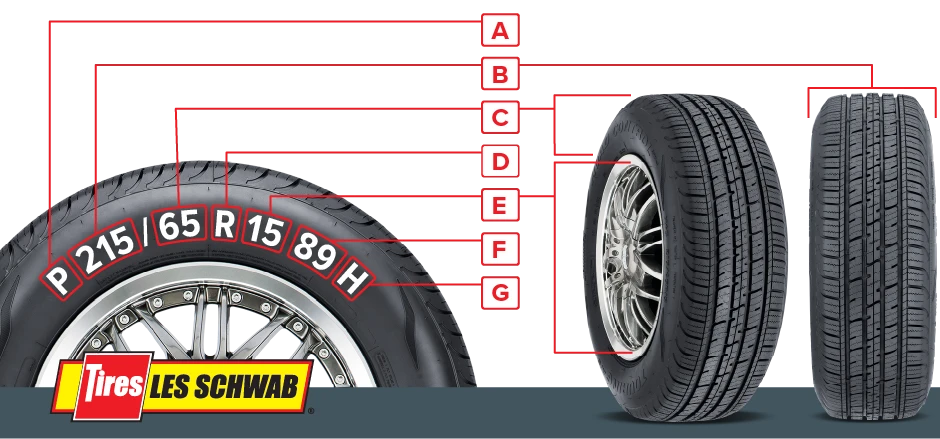
A: TIRE TYPE

The first letter in the code tells you what class of tire it is.
- P stands for passenger vehicle tire. P-class tires include cars, SUVs, crossovers, minivans and smaller pickup trucks, as well as EVs (electric vehicles). While the right load capacity can be achieved for electric vehicles with a standard passenger vehicle tire, special EV tires may be available for some vehicles. Look for the letters EV on the sidewall.
- LT means light truck tire, designed for vehicles capable of carrying heavy loads, towing trailers, or for those looking for an extra heavy-duty option. These are often equipped on three-quarter or 1-ton trucks and SUVs.
- ST stands for Special Trailer. These tire sizes are meant for trailers, including fifth wheels and other travel trailers, as well as boat and utility trailers.
If there’s no letter before the first number, you have a metric tire most commonly referred to as European size. It’s also measured in millimeters but may have a different load capacity than a P or LT tire. Confused by all the numbers and letters? The pros at Les Schwab can help.
B: TIRE WIDTH

The three-digit number following the letter is the tire’s width (from side to side, looking at the tire head-on) in millimeters. This may also be referred to as the section width.
C: ASPECT RATIO

The forward slash separates the tire width number from the two-digit aspect ratio. The bigger the aspect ratio, the higher/taller the tire’s sidewall, or “profile” as it’s sometimes called.
The aspect ratio is indicated on the tire sidewall as a percentage. It’s the height of the sidewall measured from wheel rim to top of the tread, expressed as a percentage of tire width.
In this example, the aspect ratio is 65, meaning the sidewall is 65 percent as high as the tire is wide. To get the sidewall height, take the tire width of 215 mm and convert it to inches (8.46). Then multiply this by 65% (.65). This gives you an answer of 5.5, the sidewall height in inches.
D: CONSTRUCTION TYPE

This single letter tells you about the internal construction of the tire. These include radial and bias.
R: Radial Tires
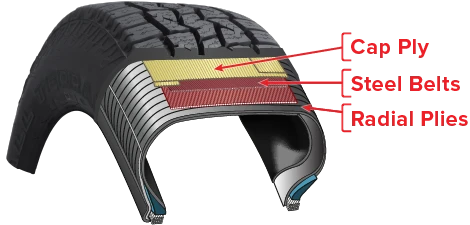
R is for radial tires, the industry standard for most tires today. They have better road grip, lower rolling resistance for better gas mileage or electric range, ride comfort and durability than previous generations of tires. In a radial tire, the plies — layers of strong cords made of a blend of polyester, steel and fabric and coated with rubber — are laid perpendicular to the direction of travel.
D: Diagonal Plies or Bias-Constructed Tires
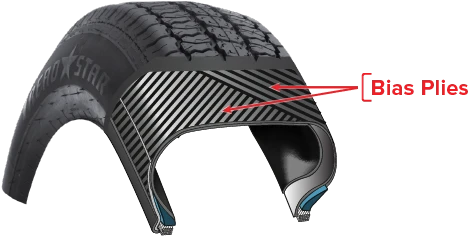
D is for tires built with diagonal (crisscrossed) plies, called bias-constructed tires. They are also called conventional, x-ply, or cross-ply tires. Some motorcycle and trailer tires still use this internal construction.
E: WHEEL DIAMETER

This two-digit number specifies wheel diameter in inches. It’s the distance between the two bead seat areas (where a tire gets tightly sealed onto the wheel).
F: LOAD INDEX

The two-digit or three-digit number that follows the gap specifies tire load index.
The load index symbol indicates how much weight a tire can support, based on the following standard chart (see below). In our example, the load index is 89. This means the tire has a load capacity of 1,279 pounds, when inflated to the tire’s maximum air pressure rating.
Please note: Some run-flat tires are identified with an F followed by the type of internal construction.
G: SPEED RATING

The last letter is the tire speed rating.
This indicates the top speed it’s safe to travel for a sustained amount of time. A tire with a higher speed rating can handle heat better and provide more control at faster speeds. The maximum operating speed of a vehicle is no more than the lowest speed rating of all tires mounted on the vehicle. (Of course, you should always abide by speed limits for safer driving.) Speed rating is usually, but not always, a single letter (see the chart below).
Tire Size Charts
Below you will find several charts that will help you understand tire sizing numbers, including a load index chart and speed rating chart.
LOAD INDEX
LOAD INDEX LOAD (lbs) LOAD INDEX LOAD (lbs) LOAD INDEX LOAD (lbs) 65 639 94 1477 123 3417 66 661 95 1521 124 3527 67 677 96 1565 125 3638 68 694 97 1609 126 3748 69 716 98 1653 127 3858 70 739 99 1709 128 3968 71 761 100 1764 129 4079 72 783 101 1819 130 4189 73 805 102 1874 131 4299 74 827 103 1929 132 4409 75 853 104 1984 133 4541 76 882 105 2039 134 4674 77 908 106 2094 135 4806 78 937 107 2149 136 4938 79 963 108 2205 137 5071 80 992 109 2271 138 5203 81 1019 110 2337 139 5357 82 1047 111 2403 140 5512 83 1074 112 2469 141 5677 84 1102 113 2535 142 5842 85 1135 114 2601 143 6008 86 1168 115 2679 144 6173 87 1201 116 2756 145 6393 88 1235 117 2833 146 6614 89 1279 118 2910 147 6779 90 1323 119 2998 148 6944 91 1356 120 3086 149 7165 92 1389 121 3197 150 7385 93 1433 122 3307 LOAD INDEX LOAD (lbs) 65 639 66 661 67 677 68 694 69 716 70 739 71 761 72 783 73 805 74 827 75 853 76 882 77 908 78 937 79 963 80 992 81 1019 82 1047 83 1074 84 1102 85 1135 86 1168 87 1201 88 1235 89 1279 90 1323 91 1356 92 1389 93 1433 94 1477 95 1521 96 1565 97 1609 98 1653 99 1709 100 1764 101 1819 102 1874 103 1929 104 1984 105 2039 106 2094 107 2149 108 2205 109 2271 110 2337 111 2403 112 2469 113 2535 114 2601 115 2679 116 2756 117 2833 118 2910 119 2998 120 3086 121 3197 122 3307 123 3417 124 3527 125 3638 126 3748 127 3858 128 3968 129 4079 130 4189 131 4299 132 4409 133 4541 134 4674 135 4806 136 4938 137 5071 138 5203 139 5357 140 5512 141 5677 142 5842 143 6008 144 6173 145 6393 146 6614 147 6779 148 6944 149 7165 150 7385 SPEED RATING
SPEED SYMBOL SPEED (mph) A1 3 A2 6 A3 9 A4 12 A5 16 A6 19 A7 22 A8 25 B 31 C 37 D 40 E 43 F 50 G 56 J 62 K 68 L 75 M 81 N 87 P 93 Q 99 R 106 S 112 T 118 U 124 H 130 V 149 ZR* W 168 Y 186 (Y) Above 186 *For tires having a maximum speed capability above 149 mph, a ZR may appear in the size designation... above 186 mph, a ZR must appear in the size designation, including a Y speed symbol in brackets.
Buying New Wheels or Changing Your Tire Size?
A tire size calculator is a quick way to ensure a new set of tires will fit your car, SUV, sports car, light truck or crossover. But remember, this calculator is only an estimate. It’s important to stay within the sizing tolerances of your vehicle. Tires that are the wrong size could cause some pull in the steering wheel, rub against the suspension or body of your vehicle, reduce clearance on hills, or result in a stiffer or noisier ride.
If you’re considering mounting a different tire size on your vehicle, stop by Les Schwab. We’ll help you make the right choice about the tires and wheels for your vehicle’s suspension, gearing, and bodywork. See how new tires and rims will look on your car or truck. Start shopping now.
-
Understanding Les Schwab Credit Options
They say money can’t buy happiness. But Les Schwab credit and flexible financing can help you buy the tires, wheels, and services you need. Here’s a quick look at the history behind our credit plans and how we’ve designed them to work for you.
It All Started With Our Founder
Like his customers, Les Schwab was a downhome kind of guy. Sure, he owned one of the most successful tire companies in the West, but he also understood how normal families paid the bills and put food on the table. That’s why he created our Retail Payment Plan long before credit cards were used for everything. He could help customers get the tires, wheels and other services they needed with affordable payment plans that didn’t break their budget.
Today, that payment plan Les created has evolved into several options designed to help our customers get what they need today with affordable payments weeks and months down the road.
Credit for Hard-working Folks
Today’s credit plans include our Retail Payment Plan, Equal Pay, and 90-Days Same as Cash. Of course, every account is based on creditworthiness and other qualifications*. Plus, they’re designed to keep things affordable for our customers.
Retail Payment Plan is the most popular. Your minimum monthly payment depends on your ending monthly balance. That means your monthly payment goes down as you pay the balance. Let’s say a customer buys a set of tires that adds up to $400. Their minimum monthly payment would be $50. In just four months, when the balance drops below $250, the new monthly payment would be $25. You can see why it’s a favorite.
Ending Monthly Balance Minimum Payment Due $0.01 - $10.00 Balance $10.01 - $50.00 $10.00 $50.01 - $100.00 $15.00 $100.01 - $250.00 $25.00 $250.01 - $500.00 $50.00 $500.01 - $1,500.00 $75.00 $1,500.01 - $2,500.00 $150.00 Over $2,500.00 1/3 of Balance Equal Pay is a nice option for those who like consistent, monthly payments and the option to buy more with their line-of-credit. The monthly payments are calculated at 5% of the highest balance on the account. If a person financed $500, their payment would be $25 until it was paid in full.
90-Days Same as Cash is exactly what it sounds like. As long as the balance is paid in full in 90 days, there are no interest charges.
Helping Local Business Succeed
Similar to our plans for families, Les Schwab is proud to offer credit to businesses. These include the Commercial Payment Plan, Equal Pay, and 30-Day Payment Plan.
Commercial Payment Plans allow businesses to get the tires, wheels and services they need for their fleets and other vehicles and only pay 1/3 of the balance each month. As the balance goes down, the monthly payment drops. It’s a great way to manage overhead and keep a business running strong.
Equal Pay for business is an easy-to-use revolving line of credit with monthly payments calculated at 10% of the highest balance on the account.
30-Day Payment Plans are designed for businesses that prefer to pay by invoice and pay their account balance in full each month.
Finance What You Need
Les Schwab financing options are designed to be simple and straightforward for everyone. The application is easy, and using your line-of-credit is even easier at any Les Schwab location. Qualify, and we’ll get you the credit you need to keep your vehicle and budget heading in the right direction.
Les Schwab Is on Your Side
Learn more about your credit options and apply today, with no annual fees or hidden charges. Or stop by any Les Schwab location and ask about flexible financing.
* The Les Schwab Revolving Credit Plan has a fixed rate of 18.0% APR (0.04931% daily periodic rate) and a minimum finance charge of $0.50 or 18.0% APR, whichever is greater, on average daily balances over $10.00.
-
TPMS Light Coming on in Cold Weather? Here’s Why
Every year, the first cold days play havoc with TPMS (tire pressure monitoring systems). If your dashboard TPMS light has ever lit up on a colder-than-normal day, chances are there may be nothing wrong with your tires or wheels. It could be that the air pressure in your tires has been affected by the cold. While you’re always welcome to stop by Les Schwab to have your tire pressure checked anytime you see the TPMS indicator, here’s why your low-pressure tire light comes on and what to do when it happens to you.
How Does Cold Weather Affect My Tire Pressure?
Tire pressure can decrease about 1 PSI (pounds per square inch) for every 10 degrees the temperature drops. It’s not due to air escaping, but rather the air inside the tire condensing. Once it does that, it takes up less space inside the tire. When a tire drops below the recommended fill pressure, the TPMS light comes on. Thankfully, that pressure change is usually temporary. Driving will often heat up the tire and the air inside, increasing the tire’s pressure.
Please Note: Tires routinely lose 1 PSI per month as air escapes around the edge of the rim and through the tread itself. This is completely normal, which is why you should have your tire pressure checked and topped off every month at Les Schwab.
If the TPMS light does not go off after the tires have heated up, bring your tires up to the proper pressure or have your air pressure checked at Les Schwab. If it still does not turn off, you may need to reset the TPMS light.
What Is a TPMS Light?
The tire pressure light (or low-pressure indicator) is just one part of the TPMS system. Some vehicles have two dash indicators.
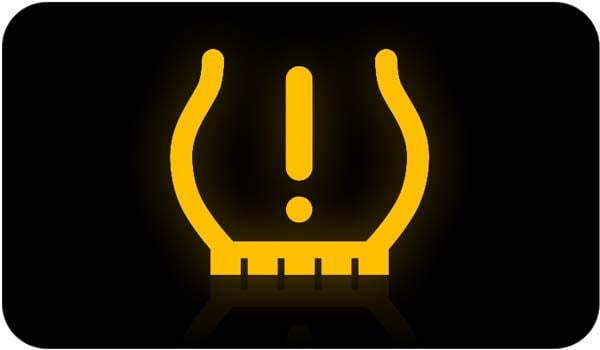
Low Pressure Indicator
The low-pressure indicator looks like an exclamation point in the middle of an open-top, flat tire. This lights up when the pressure in one or more of your tires falls below the recommended fill pressure.
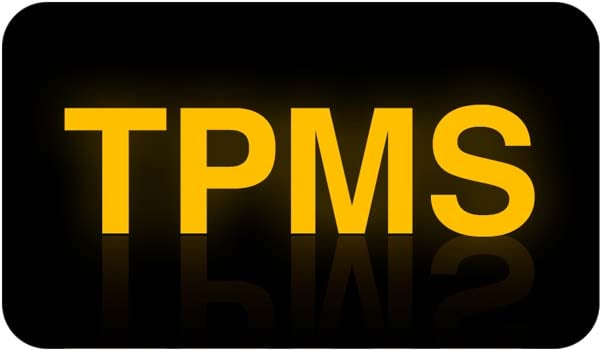
TPMS System Indicator
The TPMS light, available in some vehicles, may light up indicating an issue with the tire pressure monitoring system, such as a dead battery in one of the tire-pressure sensors. If your vehicle does not have a TPMS light, the low-pressure icon might flash, which could indicate an issue with the system.
No matter what causes your tire pressure light to turn on, stop by any Les Schwab. We’ll add air to your tires and check out your system.
Winter Tire Pressure
Winter temperatures can affect the pressure in your tires by up to 10 PSI. Depending on how cold it is, the TPMS light will likely shut off on its own as the air in your tires warms, expands, and reaches proper inflation levels.
Regardless, get your air checked right away. The TPMS light means your tires are below the proper air pressure. This is a safety risk, especially in the winter as the drop in air pressure can cause compromised handling and increased wear and tear on your tires. Your gas mileage could also be affected.
Can You Drive With a Low Tire Pressure Light?
Driving too long with the TPMS light on (and low air pressure) could affect your safety, including handling and braking. It can also decrease fuel efficiency, damage your tire sidewalls, and cause uneven tread wear. If the TPMS light does not go off after you have added air, get to Les Schwab immediately or change to your spare (if you know which tire is low) and stop by as soon as possible.
Does Air Pressure Impact Tire Life and Fuel Efficiency?
Maintaining proper air pressure can extend tire life by promoting even tread wear. Plus, correct air pressure can improve fuel efficiency by up to 3.3 percent, adding up to more miles per gallon.
One More Reason Your TPMS Light May Turn On
Your TPMS light may flash if your vehicle’s onboard computer can’t detect the sensor, whether it has been damaged or you are using your spare tire. While many vehicle spares do have a sensor, some do not.
How Do I Check My Tire Pressure?
During colder months, we recommend you have your tire pressure checked once a month. Throughout warmer months, you might not need to check your tires as frequently. You can check your tire pressure by following the steps below or by watching our video.
How to Add Air to Your Tires
Learn how to add air to your tires.
1. Find Your Recommended Tire Pressure:
Look in your owner’s manual or for a special sticker on the inside driver’s side door for the standard cold tire inflation pressure. This number is the suggested PSI for your tires, as suggested by the vehicle manufacturer.
Please Note: If you suspect a tire or wheel on your vehicle may be damaged, change to a spare and head to Les Schwab. We will inspect it for free.
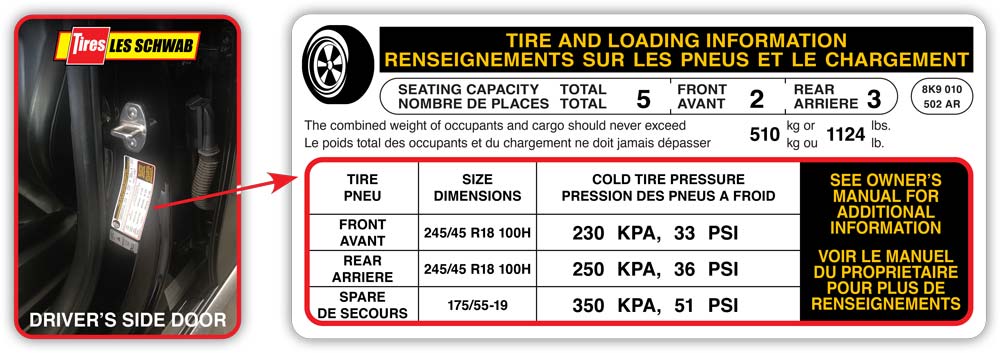
2. Check Your Tire Pressure:
Verify the pressure in each tire in the morning or when the tires are cold. This will give you an accurate reading. To check the pressure in each tire, use a tire pressure gauge. These often look like a metallic pencil with a sliding measuring device on one end and a tire valve connection on the other.

3. Park Your Car in a Convenient Location:
Whether you’re at a gas station or home, be sure you can safely reach all four tires with the air hose.
4. Remove the Tire Valve Cap:
Put the cap in your pocket so you don’t lose it.5. Place the Compressor Fitting Firmly on the Tire Valve Stem:
Begin to inflate your tire. You’ll hear air going into the tire. If you hear or feel air coming out, readjust the connection between the air nozzle and the value stem.
6. Add Air for a Few Seconds:
Keep in mind that not all air compressors inflate at the same rate. You’ll want to check your tire pressure often as you inflate. Add air as needed. To remove air, quickly push in the center pin located inside the tire valve.
7. Replace the Valve Cap:
This helps keep more air in your tires for a longer period of time and can keep road debris (dirt and more) from getting into the valve.
Les Schwab Understands Air Pressure
If you need help with the air pressure in your tires, find a Les Schwab store near you. Our knowledgeable technicians will perform a free visual inspection, inflate your tires to the recommended pressure, and get you safely back on the road.
-
Want Quiet Tires? Look for These Features
If you put a high priority on a quiet ride, your tire selection is important. Tread patterns, wheel size and traction elements can all affect tire noise.
Tire Features That Cut Road Noise
Tire noise reduction is a science. Designers have figured out how to tune tread patterns to change the harmonics and disrupt air flow. There are sizing and rating considerations, too. Here’s what to look for to get quieter tires:
- Continuous, circumferential ribs with straight grooves in between.
- Varied tread block shapes that create a multiple pitch pattern.
- Smaller blocks.
- A reinforced shoulder, which stabilizes tread blocks.
- Small hash marks inside the grooves that break up air flow.
- Narrower tire sizes.
- Softer rubber composition.
What’s That Noise?
There’s more to quiet ride quality than your tires. The engine, suspension, transmission and wind all generate exterior sound. Road texture also matters. A mountain highway paved with asphalt that offers more winter traction will generally sound louder than the smooth blacktop on a freeway.
As for tires, there are several sources of noise. The air chamber inside the tire is one. Like a drum, the space inside a tire is big and empty. As the tire rolls, the vibration in this space causes a low-frequency hum.
Tread pattern and air flow also come into play. Tires with uniformly shaped tread blocks (the segments of the tire between the grooves) can produce a whining sound, known as harmonic noise. Differently shaped tread blocks create noise at different pitches that tend to cancel each other out, making it less noticeable to the human ear.
Tires with tall tread blocks, like on a traction tire, may squirm a bit which can also increase noise. The sound of air circulating through tire grooves and large voids adds noise.
Heavy-duty tires designed to carry big loads may produce more noise. Traction tires that have more space between the lugs that help with off-road traction are noisier. Tires that are getting to the end of their tread life may be louder since there’s less rubber between the steel belts inside and the road. Unevenly worn tires are likewise noisy: When the tread loses its uniform shape, the sound-muting features built into the tread pattern get distorted. They cannot perform as intended to reduce noise.
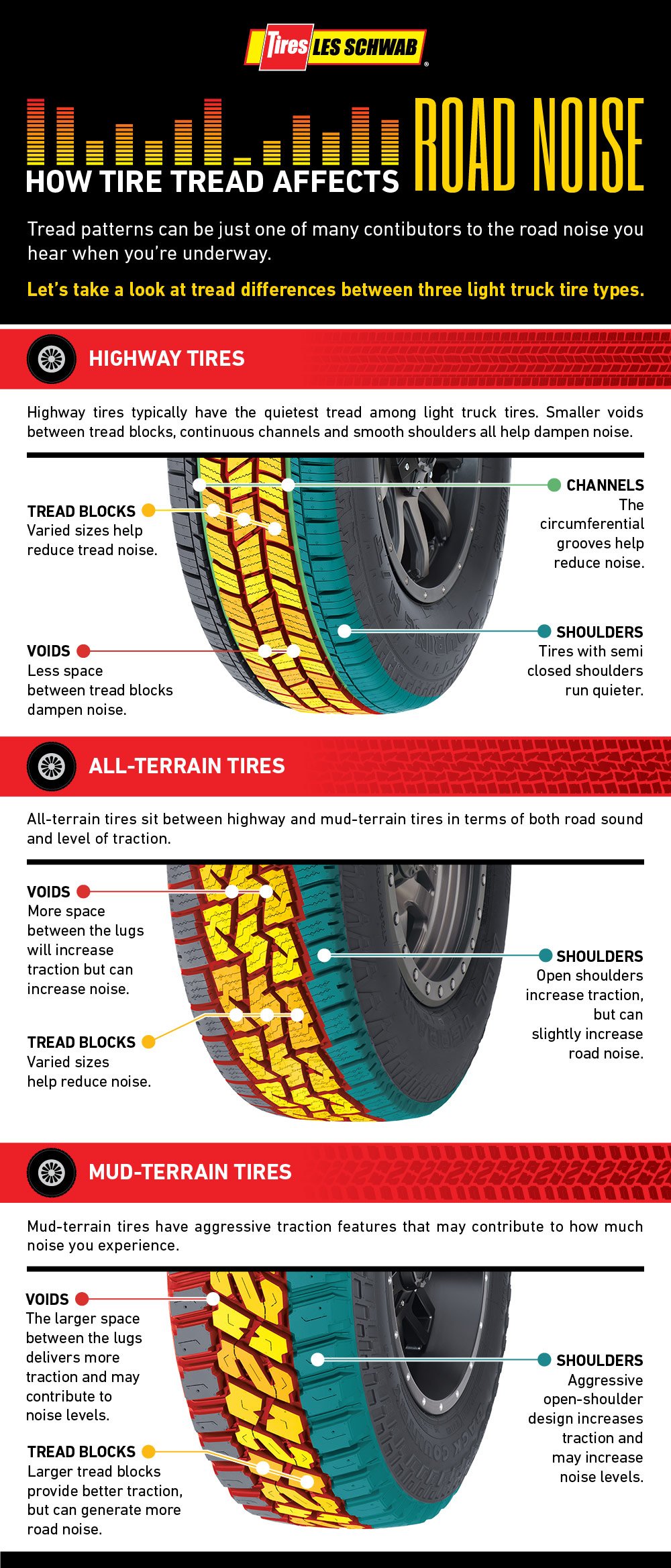
Other Factors in a Quiet Ride
Your vehicle type and options play a large role in how loud the ride is. A softer suspension generally means lower noise. Laminated windows can dampen sound. Station wagons are considered louder than sedans, which trap some of the road noise in the trunk. SUVs and trucks will have more wind noise. Accessories like tow mirrors and roof racks will also cause noise. Electric vehicles generate almost no engine noise.
To reduce tire noise, drive at slower speeds and keep tires fully inflated to the recommended air pressure for a quieter ride. Tires will stay quieter longer with simple maintenance that promotes even treadwear: regular rotations, rebalancing and alignments.
If you’re really after that catlike quiet, consider a luxury car that delivers the best insulation from engine, pavement and wind noise.
Tire Types from Quietest to Noisiest
Today’s passenger cars are an estimated 80 percent quieter and trucks 90 percent quieter than those made in the ‘80s. It’s a good thing, given all we have going on inside modern-day vehicles: GPS instructions, stereo and passengers involved in cellphone conversations, videos or games.
But some classes of tires are always going to be noisier than others.
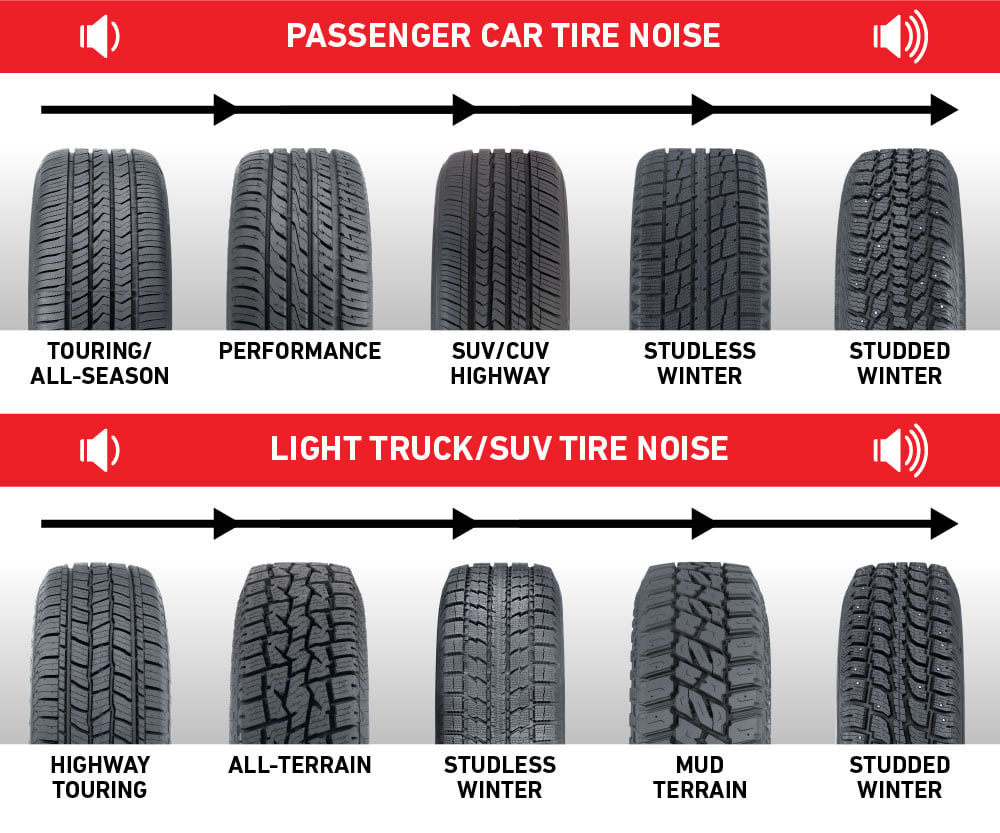
If noise is a top priority, ask your tire dealer about the quietest tires in each category. Noise-reduction technology is always advancing so there may be new options on the market that can improve your driving experience.
-
How to Tell If You Need New Tires
Every year in the U.S., tire-related crashes cause 200 fatalities, according to the National Highway Traffic Safety Administration. Thankfully, it’s easy to monitor your tires, and how to tell if you need new tires, with a quick video and some basic information.
5 Warning Signs You Need New Tires
The primary functions of the tread on your tires are to grip the road and to divert water that causes hydroplaning. Tires with plenty of tread can help you maintain control and reduce your chances of getting a flat. With a quick monthly check of your tread and tire pressure, you’ll know if you need to replace your tires.
Tread Wear Bars are Flush with the Tread:
Tread wear bars are small, raised bits of rubber that run between the tread blocks. As these bars become even with the top of the tread, it is likely time for new tires. See more about tread wear bars below.
Cracked Rubber:
Tires will wear down over time, even if you don’t drive much. Sunlight, heat, and chemicals used to melt snow and ice can reduce rubber flexibility, causing tires to crack, lose air, and eventually fail.
Uneven Tire Tread:
There are many factors that may cause uneven wear, which could shorten the life of your tires. Vehicle alignment, tire pressure, lack of rotation, and/or worn steering and suspension components can all contribute to this problem. To prolong the life of your tires and reduce uneven wear, consider getting them rotated at consistent intervals. At Les Schwab, we recommend getting them rotated every 5,000 milles. The pros at Les Schwab will also conduct a free visual inspection of your steering and suspension components. Schedule your free, pre-trip safety check today.
Tire Pressure Issues:
All tires deflate slowly over time, usually about 1 PSI (pounds per square inch) per month. Check yours monthly to keep them properly inflated. If your tires continually lose air or seem to completely deflate without warning, you may need to stop by Les Schwab for tire repair or replacement if necessary. Does the TPMS (Tire Pressure Monitoring System) light often appear on your dash? This could mean your tires have developed a slow, continuous leak.
Sidewall Bulges:
If you hit a curb, pothole or other obstacle, your tires can develop sidewall bulges due to a break of the inner liner. These bulges can rupture causing a potentially unsafe situation. If you spot a bulge on your tires, get to your nearby Les Schwab and have your tires inspected.
Other Possible Issues:
If you experience new vibrations or thumping while driving, it could be a sign that one of your tire/wheel assemblies is out of balance. It could also indicate a suspension issue. Stop by your local Les Schwab and our professionals will check your tires, steering, and suspension.
Easy Ways to Check Your Tread
Use the Tread Wear Bars
All tires sold in the United States today have what are called tread wear bars. The tread wear bars on your tires are there to help you see how much tread you still have. These wear bars are small, raised bars of rubber in the grooves of your tire. Look at the tread pattern and you’ll see these bars running between the tread blocks.
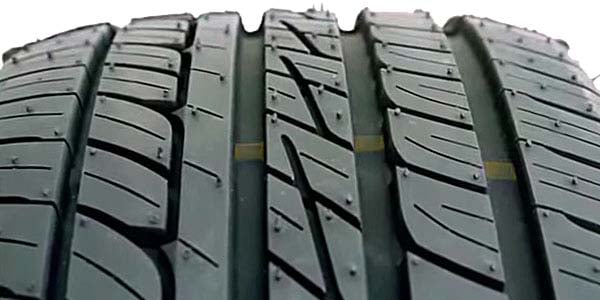
How do I use them to diagnose worn tires?
Look at the tread pattern and you’ll see these bars running between the tread blocks. As your tires wear, these bars will become increasingly flush with the tire’s tread. It’s important to replace your tires before this happens.
Depending on where and how you drive, and the conditions you face on the road, you might consider getting new tires before they reach that point. City driving in mild conditions may allow you to wait until the tread is closer to the tread wear bar before replacing your tires. More adverse conditions, such as rain, snow, and unpaved roads, may require you to replace your tires earlier.
Do the Penny Test
An easy way to check the tread on your tires is to do the penny test. Take a penny and place Lincoln’s head in one of the grooves of the tire tread. If you can see all of Lincoln’s head, it’s time to replace the tire.
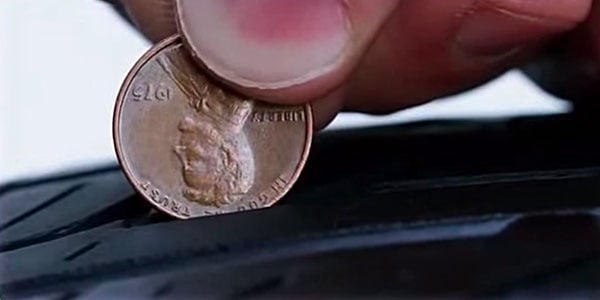
If the penny goes in enough that the tire tread is at least as deep as Lincoln’s forehead, your tires are generally considered safe and do not need replacing. Check all four of your tires when conducting the penny test.
Ready to Find the Perfect Tires?
You’ll find your next set of tires at Les Schwab. You also find our world-class customer service at a tire shop near you that cares about your safety on the road.
-
What are Directional Tires?
Directional tires have a tread pattern designed to rotate in only one direction. When you look at such tires head on, the lateral voids and channels on the tread all point forward and down. The channels on both sides of the tread will run like two waterfalls joining from opposite sides, like this: ϒ
Directional tires (also called unidirectional) are better for performance cars — and traveling at high speeds — than tires with symmetrical or asymmetrical tread patterns. The tires channel water away efficiently for excellent hydroplaning resistance and deliver sporty performance on dry surfaces.
But directional tires cannot be easily rotated to as many positions on the vehicle. In order to rotate directionals to opposite sides of a vehicle — not just between front and back on the same side — the tires have to be dismounted from the wheels and remounted before being installed.
For this reason, most drivers end up just switching directional tires from front to back on the same side when they get a rotation. This means the tires will wear less evenly and more quickly, and that’s why you may get less mileage.
How to Identify Directional Tires
Most directional tires have a solid center rib, which adds rigidity for high-speed stability. Also, the lateral channels on the tread pattern all point down in a V-shape. Such designs are used on summer or winter tires.
Here’s a comparison between directional, symmetrical and asymmetrical treads.
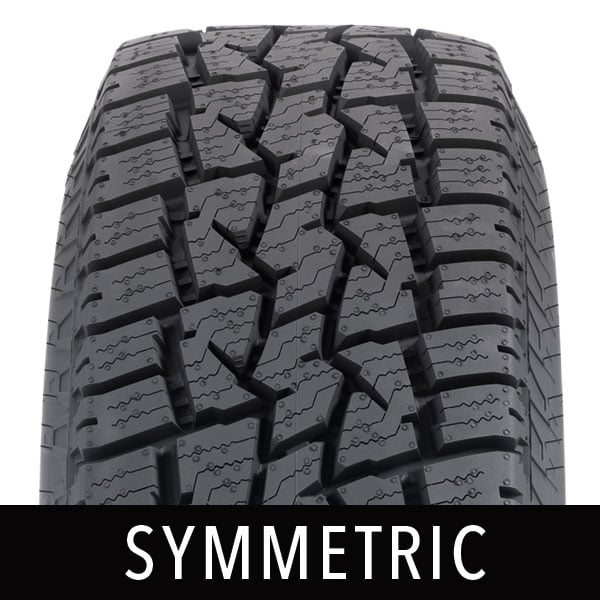
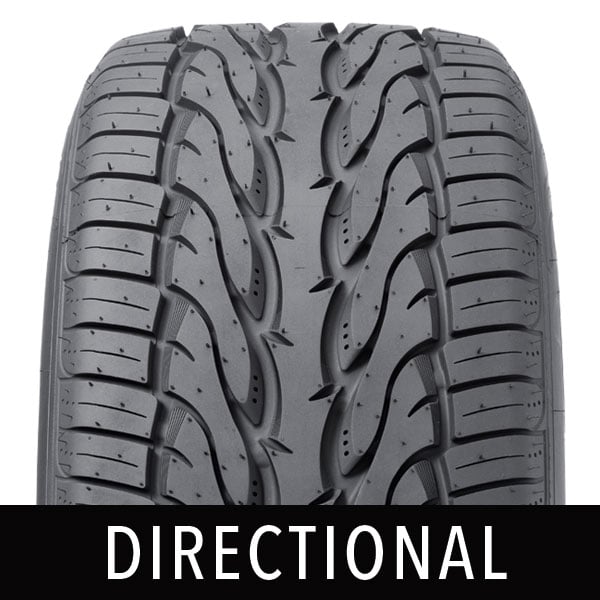
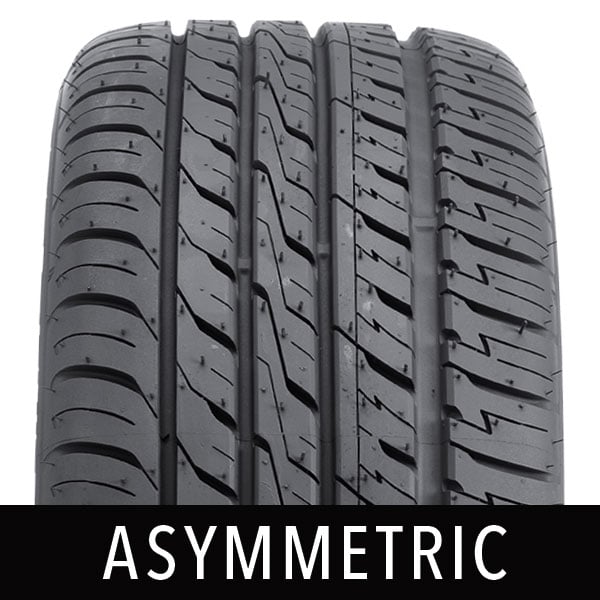
The most common tread pattern for passenger cars is symmetric. The left and right tread blocks mirror each other, and the grooves and voids point in multiple directions. Both summer and winter tires use this type of pattern.
Asymmetric treads combine the above two patterns to offer good grip on dry, wet or snowy roads, making the tread type a better choice for all-season use. The inner side of asymmetric tires often features lateral voids like those found in directionals, while the outer side uses larger tread blocks.
Installing and Rotating
On directional tires, there’s an arrow on the sidewall of the tires — when correctly mounted, the arrow points toward the front of the vehicle. If directional tires get mounted backward, you won’t get the hydroplaning resistance and other performance driving benefits the tread is designed for.
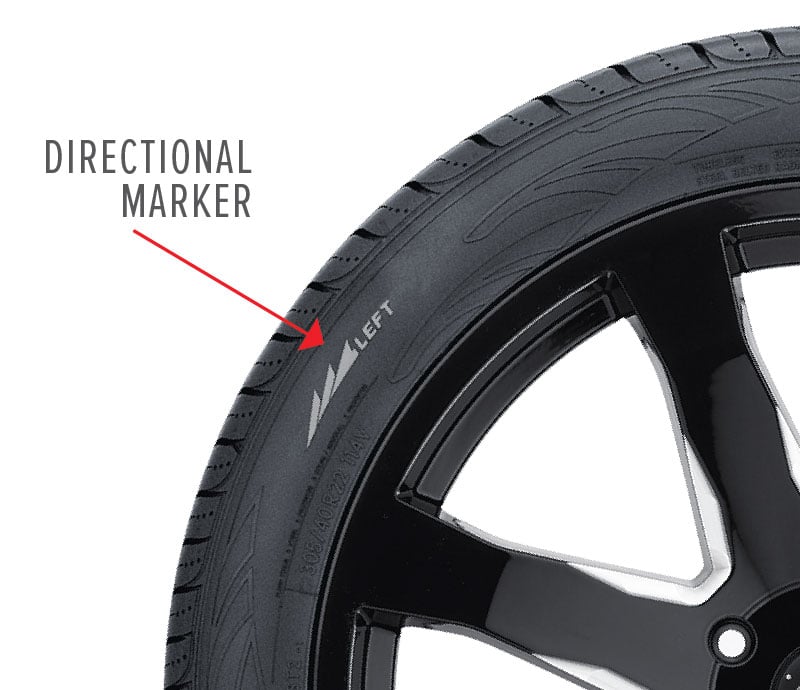
Front and rear tires often wear at different rates. It is recommended to rotate standard tires between front and back and crossways to maximize lifetime mileage.
When you have directional tires, you can only easily swap fronts for rears on the same side of the car. If you want to cross tires to opposite sides, you’ll have to go through the time and expense of having the tires taken off the wheels, flipped, remounted on the wheels and swapped.
Pros and Cons
Directional tires provide superior handling in wet conditions or dry. The V-shaped tread allows water to be pushed outward as the tire rotates, evacuating water better than a symmetric tire.
The tires handle better at high speeds. Most race and sports cars run with directional tires.
Directionals can also provide better fuel efficiency since they have less rolling resistance. (But if you’re a spirited driver, faster accelerations and speeds may offset these gains.)
The main downside is cost. The rubber compounds used in these high-performance tires mean a premium price point compared to standard passenger car tires.
Also, directionals typically have shorter tread life. It’s not because the tread is less durable, but rather it’s because tire rotations involve extra labor and cost. Many drivers opt to swap front and rear tires on the same side to avoid the hassle.
SHOP TIRES -
Tire FAQ
How Do I Know If I Need New Tires?
Signs that your tires are wearing out or may need replacing include uneven wear, a decline in vehicle handling performance or ride, poor gas mileage, vibration, reduced brake responsiveness, tread that looks slick, and a tire that’s losing air faster than it should. Just stop by any Les Schwab for an honest opinion on the condition of your tires.
How Often Should I Replace My Tires?
It depends on many factors, including your driving style, the mileage rating for the tires, conditions on the roads you typically travel, weather, and more. Bring your vehicle in anytime for a free visual inspection on how your tires are doing.
What Are the Parts of a Tire?
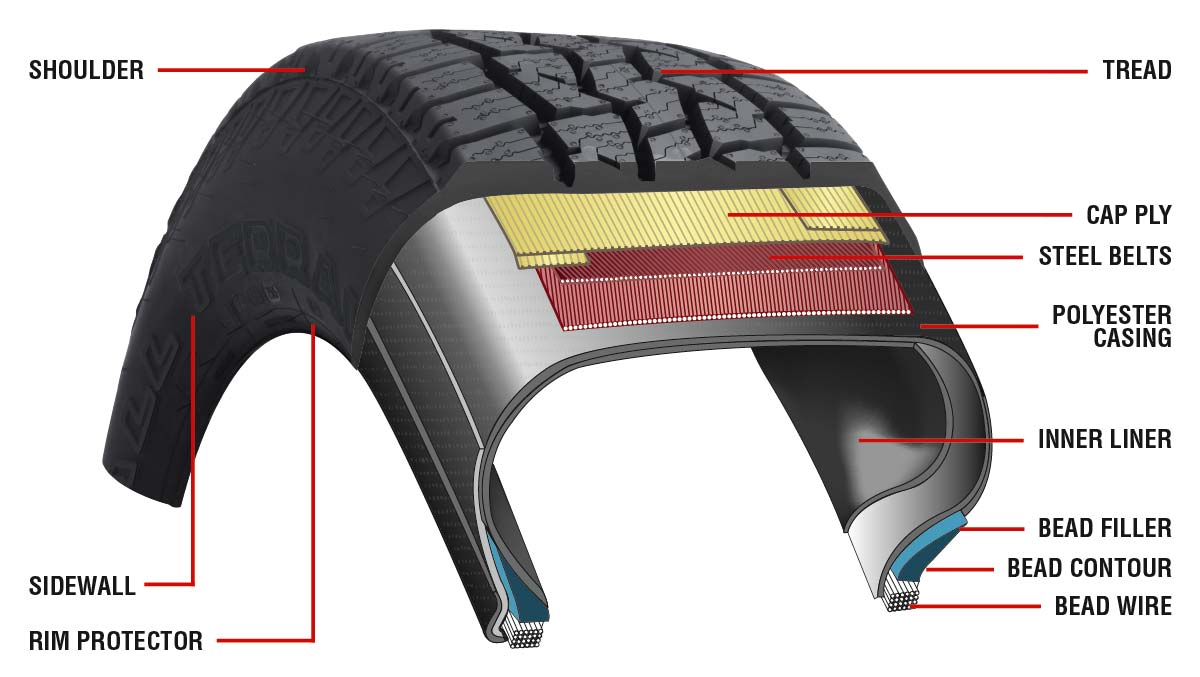
Having a basic understanding of tire parts and how your tires are constructed can be useful when it comes time to buy tires. Here are the key components.
What Do the Numbers on the Sidewall Mean?
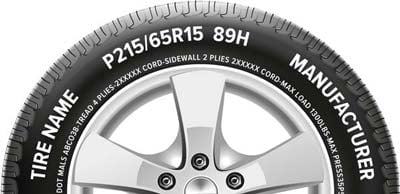
It’s a good idea to understand what the codes and numbers on the side of your tire mean. Learn more about reading your tire sidewall.
SHOP TIRES -
5 Questions Any Good Tire Dealer Should Ask
Tires are a big investment most people make only every few years. If you want to make the right decision, you’ve got two choices:
- Become a tire selection expert.
- Become a tire dealer selection expert.
Option 2 is a lot easier. Make sure the salesperson asks you these five questions:
1. “What do you use your vehicle for?”
The best tire for a commuter in an economy car may not be the same as what’s needed for the family car. The tire that’s best for comfort and least noise for your long-distance commute may be overkill for a third car that's used less often. If you’re hauling loads or a trailer with your truck, that suggests a different choice than what’s right on a truck used for lighter duty.
Road conditions are a part of this equation. If you regularly go off-road, you’re driving streets with lots of potholes, or you live in a place with winding roads and tight curves, the salesperson’s recommendations will differ.
2. “What are your driving habits?”
If your dealer asks this question, they’re a keeper.
Literally and figuratively, tires aren’t one-size-fits-all. For example, a new driver in the family can change the ideal tire. So can your tendency towards conservative versus faster driving.
3. “Will you be doing any driving in winter conditions?”
You need tires that suit the weather conditions where you drive and your dealer knows that. A good one will ask.
All season tires are the choice for drivers in sunnier places. If you’re driving on snow or ice every year, you’ll likely have winter tires for cold months and a different set for warmer weather. Your dealer’s recommendation on what’s going to last longest and perform best will also be different if you live in a place with extremes of heat and cold than someplace with more consistent weather.
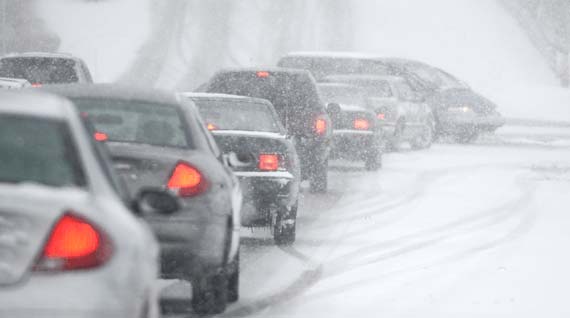
4. “What’s your budget?”
All these factors — driving habits, safety, longevity, comfort, handling, noise — have to be balanced with your budget. A good dealer is happy to explain the differences between a quality, basic tire, a premium tire, and everything in between, because it narrows the choices to what's best for you. You should never get the feeling the store rep is pushing a tire just because it’s on sale or it’s the most expensive.
5. “Here’s how our warranty works …”
OK, it’s not really a question. But the best dealers will bring this up. If you want to get the best value for the money, it’s really important to think this through. Service warranties can include free services worth hundreds of dollars over the life of a tire. They vary substantially by dealer. Some features and limitations to find out about:
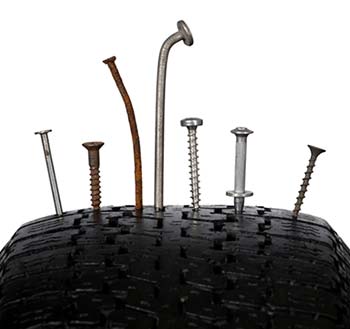
Does your service warranty cover flat tires?
- Road hazards: If you run over a pothole, nail, or debris that damages the tire beyond repair, is the value of the tire covered?
- Expiration: How long is the tire covered? Three years? Five years? The life of the tire?
- Workmanship: Are both the tire and the quality of installation/repairs covered?
- Free services: Are regular inspections for wear, tire rotations and rebalancing included? What’s the cost to fix flats?
- Locations: How many stores will honor the warranty? The service warranty that comes with tires you buy at a dealer is an agreement with the dealer, not the manufacturer. A service warranty goes beyond the standard workmanship and material warranty you get from the company that made your tires. It can cover labor and free maintenance services. But your service warranty is good only at the retailer that sold you the tires. (If you’re weighing buying online, consider that if you get a flat, or a tire is defective, you have to get it off your vehicle and return it yourself.)
Find the Right Dealer and You Don’t Have To Become a Tire Expert
Real professionals will be happy to talk your ear off about technical features — tread bars, siping, harmonic noise — or just give you the basic benefits of a tire in layperson’s language, your preference. Make sure they’re asking the questions above as a starting point. The answers will make the best choice obvious.
-
14 Items to Put in Your Winter Road Trip Safety Kit
If you’re going over the hills, through the woods or over a mountain pass during wintry months, do yourself a favor. Put a winter road trip kit in your vehicle, just in case.
Icy roads and traffic jams in cold weather aren’t predictable. Preparing in advance may save you some misery...and keep you safer in bad driving conditions.
Here Are Items to Put in a Winter Road Trip Safety Kit to Keep in Your Vehicle During the Cold Months.
- Plastic storage tub for keeping it all together and dry. And easy stowing when warmer weather returns.
- Headlamp. It could be not only snowing but dark when you realize you’re going to have to put on the snow chains.
- Speaking of tire chains, don’t forget them. If you have several sets of chains for several vehicles, putting the right chains in a dedicated winter safety kit for each car will keep you from being stranded with the wrong chains when you need them. (Here’s a video on how to install chains.)
- Reflective gear. A fluorescent safety vest with reflective strips can be bought at most big box home improvement stores. Orange warning triangles are available at most auto parts stores.
- Windshield ice scraper, in case of freezing rain, sleet or heavy snow.
- Waterproof jacket with a hood and rainpants. You’ll be glad to have that hood to keep snow from going down your back if you need to put on chains.
- Something to sit or kneel on when installing chains. Snowy or icy pavement is not a comfortable surface. A small tarp or even a piece of cardboard will really help.
- Gloves. Mittens won’t do you much good if you’re installing snow chains. Get gloves that are water resistant.
- Beanie or baseball cap. A knit hat that covers your ears will keep your head warm. Or a cap with a bill will keep snow from hitting your face.
- A towel to use after snow chain installation and removal, to put on the seat to keep it dry from your wet outer layers.
- Water. If there’s an accident on the pass you could be idled for hours. It’s a good idea to carry some water.
- Snacks. Keep a few energy or protein bars with a long shelf life in your kit.
- Kid items. Long road delays+hungry kids = nightmare. An extra diaper, a deck of cards and bag of snacks won’t take up much room and could make things a lot more tolerable.
- Pet items. A foldable fabric water bowl, spare leash and treats will be rewarded with lots of wags.
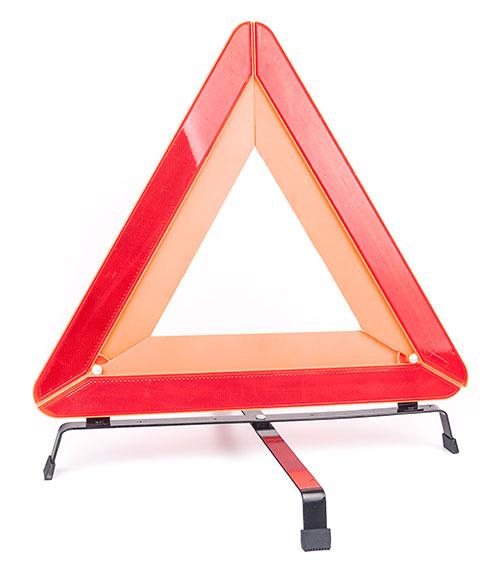
And one last thing: keep waterproof shoes handy inside your vehicle. Driving to your destination with wet feet in winter is no fun. Bring along the galoshes, just in case.
Want more tips on winter road safety? See 19 Winter Driving Resources You Can’t Do Without.
Did you know you can get a free pre-trip safety check for your vehicle at Les Schwab? Find out more here.
-
Do You Even Need a Spare Tire?
The fact that spare tires are no longer standard equipment on many newer-model cars can come as a surprise when you get a flat tire. While many new light trucks and larger SUVs come with a spare, many new vehicles do not include a regular-sized spare.
About one-third of new vehicles are not equipped with a full-size spare tire. Instead, many are equipped with a space-saver (donut) spare or tire sealant and inflation kit.
Getting a flat tire is a major hassle and can be costly. Here’s what to know about spares, including why more vehicles don’t come with one, how to decide if you really need one, and the upsides and downsides of inflator kits.
Which New Car & SUV Models Don’t Include a Spare?
The answer to that question is complicated as the number of vehicles that do not include a spare continues to change. See Consumer Reports partial list of spare-less vehicle models.
It can be difficult to tell which vehicles and models come with a spare and which don’t. Especially since some trim levels include a spare tire, but not all. Do your research before you head out to the dealership. And ask the sales rep directly. If you’ve recently bought a newer model car, be sure to double-check that it has a spare or flat tire option. That way you’re prepared in case of a flat.
Why Aren’t Some New Cars Coming With a Spare Tire?
There are several reasons why automakers have removed or minimized the spare tire.
- To improve fuel efficiency. Removing the spare can reduce a vehicle’s weight by up to 50 pounds, including the jack and lug wrench. It can also improve aerodynamics by reducing air drag from a spare tire that sits below the undercarriage of a vehicle. These two factors can affect a vehicle’s MPG.
- To save space and weight. There can be a trade-off between comfort and the space in small cars. A spare can take a lot of space — especially if you’re driving a compact or sports vehicle.
- To make room for hybrid, diesel, and electric vehicle components. Batteries and emissions equipment can often take up the same space as a spare.
- To save money. Carmakers can save several hundred dollars per vehicle by foregoing the spare in new vehicles.
Where Can I Buy or Replace a Spare Tire?
According to most automakers, a spare tire should only be used to get from where you discovered your flat tire to the nearest tire repair shop. But what should you do when that spare tire needs to be replaced?
The answer depends on the type and size of spare that originally came with your vehicle. See Les Schwab to get the right spare for your vehicle.
What Are Alternatives to a Spare Tire? Are They Any Good?
Some new cars are coming from the factory equipped with inflator kits or run-flat tires that claim to make the spare tire unnecessary. There are upsides and downsides to these alternatives.
What Is a Run-flat Tire?
Run-flat tires were first designed decades ago to improve safety and steering performance of high-end sports cars in case of a tire failure. These tires were (and still are) built with either a reinforced sidewall or an internal support ring to carry the vehicle’s weight if the tire suddenly loses air pressure. Since then, run-flat tires have become more common on everyday vehicles, allowing drivers to travel without air in their tires for up to 50 miles at less than 50 MPH before getting the tire repaired or replaced.
Potential Downsides of a Run-flat Tire
Driving on a run-flat for even the shortest of distances will ruin the tire. This means it will need to be replaced. Plus, if you’re somewhere remote and get a flat, you may not be within range of the next tire repair shop. Other downsides include higher prices and reduced ride comfort.
What Is a Donut Tire?
Also known as a donut spare or space-saver tire, donut tires were designed to save space in smaller vehicles. If you drive a compact or smaller vehicle, you may have a space-saver spare.
Potential Downsides of a Donut Tire
These tires have less traction than your regular tires, are smaller, should not be driven at speeds over 50 miles per hour, and should not be used for more than 50 miles.
What Is a Self-sealing Tire?
Self-sealing tires are coated on the inside with a special sealant. When an object on the road pierces the tread, the sealant material is designed to surround the object and prevent air from escaping from the tire. This gives you time to get to a tire repair shop.
Potential Downsides of a Self-sealing Tire
The self-sealing tire won't work if a puncture is more than a quarter inch in diameter. They also don’t work for holes in the sidewall of the tire. Self-sealing tires can be difficult to repair.
What Are Inflator Kits?
Inflator/sealant kits offer a temporary fix for minor tread punctures. With many kits, you simply remove the cap from your tire’s air-inflation valve, connect the inflator kit, and then spray the sealant into the tire.
Potential Downsides of an Inflator Kit
Tire sealant kits only work on small holes in the tread, and don’t work at all for slits or holes in the sidewall. Sealants also leave grime inside the tire that can affect your TPMS (tire pressure monitoring system), the safety equipment that alerts you if you’ve lost air in a tire. Any time you use a sealant, there is a good chance you’ll need to have the TPMS sensors replaced.
When Is It Ok to Go Without a Spare Tire? And Not?
If you’re buying a new car, here are five tips to help decide if you need a spare, based on cost, safety and convenience, where you live, and what type of driving you do.
- If you live in an urban area with 24-hour towing, and you’re doing mostly daytime driving, you may be good with no spare. Just be sure you have roadside assistance coverage included in your auto insurance policy or another service. Without it, a standard tow (around 5 miles) can cost you over $100.
- Decide before you buy the vehicle if you’re willing to go spare-less. If you find yourself regretting your decision later, you’ll need to buy a tire, jack and lug wrench. Plus, there may not be space to safely carry the tire and tools in your vehicle.
- If you take a lot of road trips, routinely drive in places with long distances between service stations, or travel a lot on rough roads, you need a spare tire. Getting a flat in rural areas means you could be many miles from a repair shop. If it’s after business hours, you could be stranded for hours or overnight, and forced to pay a hefty towing fee.
- Consider how much you rely on your vehicle every day. A spare can save you a lot of time and headaches in the event of a flat tire.
Les Schwab Tires Provides Free Flat Repairs. As long as you purchased your tires from us, we repair fixable flat tires for free. Find a store near you.
-
Do You Know How to Drive If Your Tire Goes Flat?
When a tire goes flat or completely comes apart while you’re driving at highway speed, you can catch even the most experienced driver off guard.
Here’s what to do if it happens to you, along with a checklist for preventing flats.
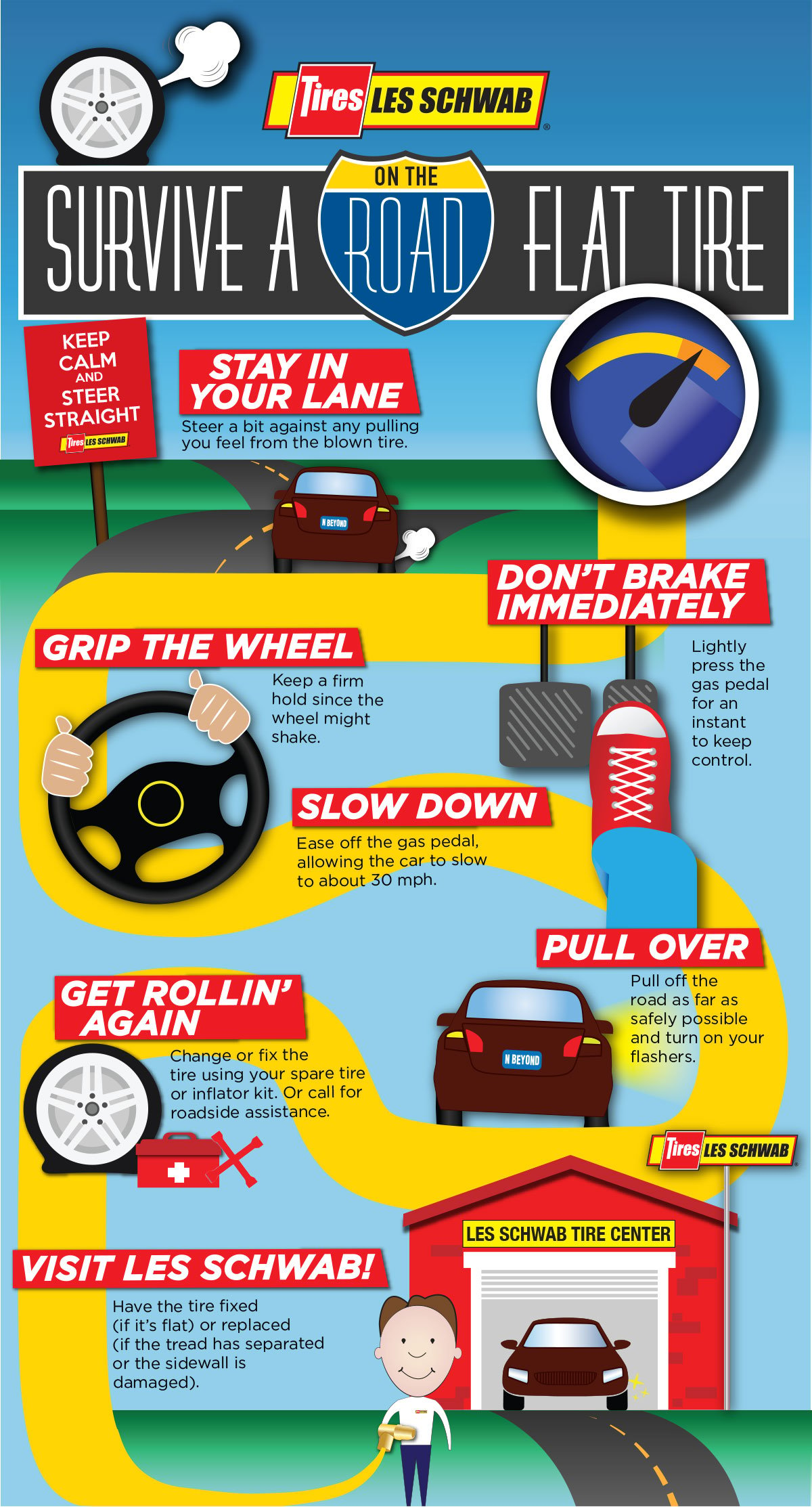
How Can You Prevent Flat Tires?
Avoid tire failure by following these easy tips.
- Check tire pressure monthly, including the spare.
- Slow down if you have to drive over a pothole or other object in the road.
- Don’t run over curbs or other foreign objects in the roadway, and try not to hit or rub the curb when parking.
- Inspect tires for uneven wear patterns on the tread, cracks, foreign objects, or other signs of wear or trauma.
- Remove any stones, bits of glass or other foreign objects wedged in the tread.
- Make sure your tire valves have caps.
- When carrying heavy loads, you should be extra careful about proper tire pressure. Overloading and low tire pressure can cause a tire to overheat, leading to tire failure.
Learn More -
Does Hitting a Pothole Damage My Tires & Suspension?
Have you ever hit a pothole so hard that you apologized to your vehicle? Hitting large asphalt chasms is never fun, but those road ravines can do more than rattle your senses or spill your favorite beverage. Repeatedly hitting potholes can puncture your tires, cut the sidewall or belts, bend or crack a wheel, damage parts of your suspension, or simply throw your car or truck out of alignment. Here’s what to look for after several run-ins with canyons in cul de sacs.
Recognizing Hidden Damages from Potholes
The damage from a pothole might not be visible right away. Small cracks on your tire’s sidewall can lead to slow leaks and eventual tire failure. If you have aluminum or steel wheels, the impact can cause a dent. That small blemish can cause an air leak between the rim and the tire. Other less visible signs of problems include damage to your shocks, springs, ball joint, struts, or tie-rods.
Give Your Vehicle a Quick Inspection
After hitting a pothole, check for any of the following signs of pothole damage.
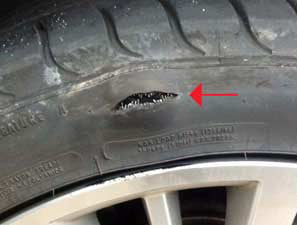
Tire Problems
A bulge or cut on the tire sidewall is an indicator that the tire was pinched or punctured between the edge of the pothole and the wheel causing the internal plies to be weakened or severed.
Steering Issues
Your steering wheel feels off-center or your vehicle wants to pull to one side or the other. The impact may have been hard enough to affect the alignment or damage a steering or suspension component.
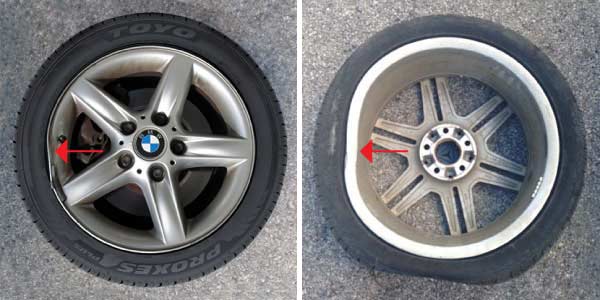
Wheel Damage
Potholes can dent or bend aluminum or steel wheels. This can cause an air leak or safety issue.
Vibrations
If you feel abnormal vibrations in the steering wheel, seat or floor, the pothole may have damaged your suspension.
Noises
New noises could mean something has been bent or displaced and could be rubbing on the tire/wheel assembly.
Warning Lights
If a dashboard warning light appears, get to your mechanic or come to any Les Schwab.
Performance Issues
There may have been damage if your cornering is impacted, your vehicle starts to sway or bob up and down a lot over speed bumps, or your steering and braking feel impacted.
How Badly Can Potholes Damage My Vehicle?
Depending on the severity of the impact and the size of the pothole, potholes can cause bent wheel rims, internal tire damage, alignment problems, as well as shock and strut issues.
But not all impacts are instantly recognizable. Some problems develop over time. If you suspect you may have bent a wheel, punctured a tire, or caused damage to any parts of your suspension, stop by anytime or book an appointment at Les Schwab for an evaluation. Ignoring any potential issues can add to the cost. Something as simple as a damaged shock or strut can cause issues to other parts of your vehicle, including your brakes.
The professionals at Les Schwab will give your vehicle an inspection for the following issues:
- Wheels/steering knocked out of alignment
- Damage to the tire’s steel belts
- Missing tire balancing weights
- Bent or cracked wheel rim
- Damage to shocks and struts
- Other broken suspension components
Tips to Minimize Post-Winter Pothole Damage
Here’s what you can do to minimize the damage when facing potholes or damaged roads.
- Always drive on tires that are properly inflated and in good condition. This will give you the best chance of absorbing the impact safely. This can also help avoid damage to your shocks, struts, and suspension.
- Drive defensively. Slow down when you’re on an unfamiliar or rough road, and avoid distracted driving.
- Be alert to what’s ahead, and make sure you keep enough distance between you and the vehicle in front of you so you can avoid issues.
- Recognize that though you might miss the first pothole, there may be another waiting.
- When you can’t avoid a pothole, take your foot off the gas and hold your steering wheel tightly. Don’t brake. This will allow you to maintain the most control during the impact.
Les Schwab Has Experience with Pothole Damage
Our pros have seen plenty of pothole damage and can offer recommendations, including tire repair and replacement, alignment work, and more. Stop by your local Les Schwab for a free inspection. If you need new tires, wheels or alignment, we’ll help get you and your family quickly and safely back on the road.
Opens warranty information dialog with language options
